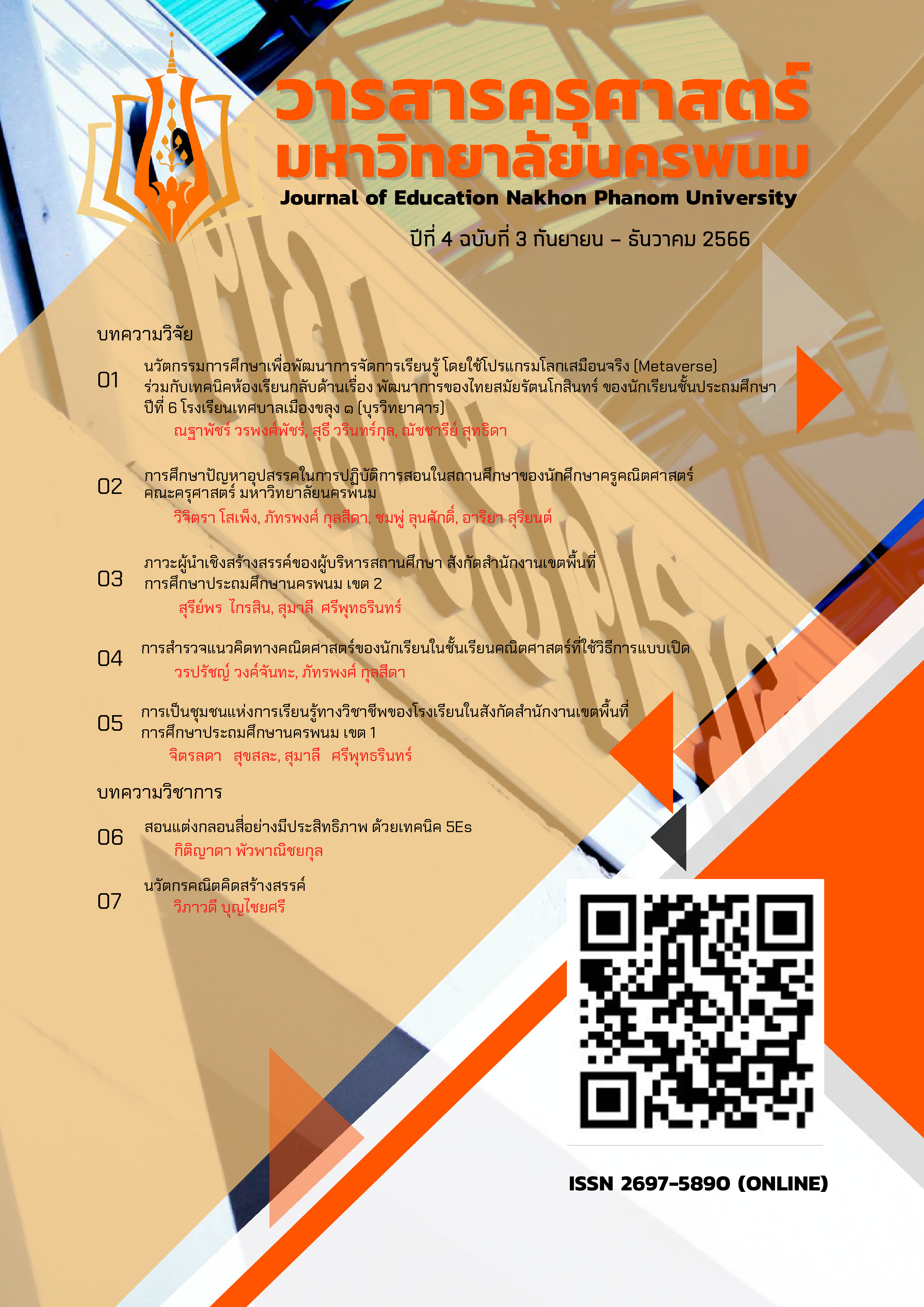การสำรวจแนวคิดทางคณิตศาสตร์ของนักเรียนในชั้นเรียนคณิตศาสตร์ที่ใช้วิธีการแบบเปิด
Main Article Content
บทคัดย่อ
การวิจัยครั้งนี้ มีวัตถุประสงค์เพื่อสำรวจแนวคิดทางคณิตศาสตร์ของนักเรียน เรื่อง เลขยกกำลัง ในชั้นเรียนคณิตศาสตร์ที่ใช้การศึกษาชั้นเรียนและวิธีการแบบเปิด ชั้นมัธยมศึกษาปีที่ 1 ภาคเรียนที่ 1 ปีการศึกษา 2565 จำนวน 20 คน โดยใช้กรอบแนวคิดเกี่ยวกับแนวคิดทางคณิตศาสตร์ของ Isoda & Katagiri (2012) ผู้วิจัยทำการเก็บรวบรวมข้อมูลโดยใช้แผนการจัดการเรียนรู้ เรื่อง เลขยกกำลัง จำนวน 5 คาบ เนื้อหาที่นำมาใช้เป็นหนังสือเรียนคณิตศาสตร์ชั้น ม.1 เล่ม 1 ของ
สถาบันส่งเสริมการสอนวิทยาศาสตร์และเทคโนโลยี (สสวท.) โดยการเขียนแผนการจัดการเรียนรู้ร่วมกันกับทีมการศึกษาชั้นเรียน เครื่องบันทึกวีดิทัศน์ และใบกิจกรรม ผลการวิจัย พบว่า ในชั้นเรียนที่ใช้วิธีการแบบเปิดมีการจัดการเรียนการสอนที่เน้นให้นักเรียนเรียนรู้ด้วยตนเองและเรียนรู้ร่วมกันกับเพื่อน ๆ ในชั้นเรียน ทำให้นักเรียนมีการแสดงแนวคิดที่หลากหลาย โดยพบแนวคิด เรื่อง เลขยกกำลังจำนวน 8 กลุ่มแนวคิด คือ 1) แนวคิดเกี่ยวกับเซต (Idea of Sets) คือ นักเรียนแสดงเซตของเลขชี้กำลังของตัวตั้ง เลขชี้กำลังของตัวคูณ เลขชี้กำลังของตัวหาร และเซตของผลลัพธ์ลงในตาราง 2) แนวคิดเกี่ยวกับหน่วย (Idea of Units) คือ นักเรียนได้พยายามหาผลลัพธ์โดยการใช้หน่วยเวลาเป็นหลักแล้วจึงหาจำนวนของแหนมีหน่วยเป็นต้น 3) แนวคิดเกี่ยวกับแสดงแทน (Idea of Representation) คือ นักเรียนได้พยายามวาดรูปแทนกระดาษที่ตัดออกทั้งหมด 128 รูป 4) แนวคิดเกี่ยวกับการดำเนินการ (Idea of Operation) คือ นักเรียนใช้ตัวดำเนินการเพื่อหาคำตอบสถานการณ์ที่กำหนดให้ 5) แนวคิดเกี่ยวกับการประมาณค่า (Idea of Approximation) คือ เมื่อนักเรียนได้ฟังสถานการณ์แล้ว นักเรียนสามารถคาดการณ์เพื่อหาวิธีการในการหาผลลัพธ์ออกมาได้ 6) แนวคิดเกี่ยวกับคุณสมบัติพื้นฐาน (Idea of Fundamental Properties) คือ นักเรียนใช้
สมบัติของเลขยกกำลังในการให้เหตุผลเพื่ออธิบายให้เกิดความเข้าใจ 7) แนวคิดเกี่ยวกับนิพจน์ (Idea of Expressions) คือนักเรียนนำเสนอความเข้าใจของตนเองโดยการพูดอธิบาย การเขียน และการแสดงออกด้วยท่าทางต่าง ๆ เช่น n2 x n4 =n6 และ 8) การคิดเชิงฟังก์ชัน (Functional Thinking) คือ นักเรียนอธิบายถึงตัวฐานของเลขยกกำลังและผลลัพธ์ที่ความสัมพันธ์กัน
คำสำคัญ: แนวคิดทางคณิตศาสตร์ ชั้นเรียนคณิตศาสตร์ การศึกษาชั้นเรียน วิธีการแบบเปิด
This research aimed to investigate students’ mathematical ideas entitled exponent in seventh grade mathematics classroom using Open Approach. The study was conducted in the first semester of the academic year 2022 with a total of 20 students. The research employed the instructional framework proposed about mathematical ideas by Isoda & Katagiri (2012) and collected data through 5 lesson plans entitled exponent based on the Mathematics textbook for grade 7, Volume 1, issued by the Institute forthe Promotion of Teaching Science and Technology (IPST). The instructional plan was developed collaboratively with the Lesson Study team, and it included visual aids and activity sheet.
The research findings revealed that in the classroom using Open Approach, students’ learning emphasized self-directed and collaborative learning, resulting in the emergence of diverse mathematical ideas. Eight mathematical ideas were identified: 1) Idea of Sets: students demonstrated an understanding of sets related to the base, exponent, multiplication, division, and the set of the results presented in a table. 2) Idea of Units: students attempted to find the result using time units as a basis and then calculated the number of units needed. 3) Idea of Representation: students made an effort to represent all cut-out pieces using drawings. 4) Idea of Operation: students employed operators to find answers to the given situations. 5) Idea of Approximation: when presented with a situation, students could make estimations to find solutions. 6) Idea of Fundamental Properties: students used the fundamental
properties of exponents to provide reasoning and explanations. 7) Idea of Expressions: students conveyed their understanding through verbal explanations, written expressions, and various gestures, such as n2 x n4 = n6. 8) Functional Thinking: students explained the foundational aspects of exponent and related outcomes.
Keywords: Mathematical Ideas, Mathematics Classroom, Lesson Study, Open Approach
Article Details

อนุญาตภายใต้เงื่อนไข Creative Commons Attribution-NonCommercial-NoDerivatives 4.0 International License.
บทความที่ได้รับการตีพิมพ์เป็นลิขสิทธิ์ของวารสารครุศาสตร์ คณะครุศาสตร์ มหาวิทยาลัยนครพนม ข้อความที่ปรากฏในบทความแต่ละเรื่องในวารสารครุศาสตร์เล่มนี้เป็นความคิดเห็นส่วนตัวของผู้เขียนแต่ละท่านไม่เกี่ยวข้องกับมหาวิทยาลัยนครพนม และคณาจารย์ท่านอื่น ๆ ในมหาวิทยาลัยฯ แต่อย่างใด ความรับผิดชอบองค์ประกอบทั้งหมดของบทความแต่ละเรื่องเป็นของผู้เขียนแต่ละท่าน หากมีความผิดพลาดใด ๆ ผู้เขียนแต่ละท่านจะรับผิดชอบบทความของตนเองแต่ผู้เดียว
เอกสารอ้างอิง
กระทรวงศึกษาธิการ. (2560). ตัวชี้วัดและสาระการเรียนรู้แกนกลางกลุ่มสาระการเรียนรู้คณิตศาสตร์ (ฉบับปรับปรุง พ.ศ. 2560) ตามหลักสูตรแกนกลางการศึกษา
ขั้นพื้นฐาน พุทธศักราช 2551. กรุงเทพ: โรงพิมพ์ชุมนุมสหกรณ์การเกษตรแห่งประเทศไทย จำกัด.
กิตติศักดิ์ ใจอ่อน. (2563). การคิดทางคณิตศาสตร์ของนักเรียน เรื่อง พื้นที่ โดยใช้การศึกษาชั้นเรียนและวิธีการแบบเปิด. วารสารศึกษาศาสตร์ มหาวิทยาลัย
สงขลานครินทร์ วิทยาเขตปัตตานี, 31(1), 28-37.
จตุพร นาสินสร้อย. (2558). การคิดทางคณิตศาสตร์ของนักเรียน เรื่อง การคูณ ในชั้นเรียนที่ใช้การศึกษาชั้นเรียนและวิธีการแบบเปิด. วารสารศึกษาศาสตร์
มหาวิทยาลัยขอนแก่น, 38(3), 133-142.
วัชรา เล่าเรียนดี. (2554). รูปแบบและกลยุทธ์การจัดการเรียนรู้เพื่อพัฒนาทักษะการคิด. นครปฐม: โรงพิมพ์มหาวิทยาลัยศิลปากร.
สถาบันส่งเสริมการสอนวิทยาศาสตร์และเทคโนโลย. (2560). คู่มือการใช้หลักสูตร กลุ่มสาระการเรียนรู้คณิตศาสตร์ (ฉบับปรับปรุง พ.ศ.2560) คณิตศาสตร์ประถม
ศึกษา. กรุงเทพ.
สุลัดดา ลอยฟ้า, และ ไมตรี อินทร์ประสิทธิ์. (2547). การพัฒนาวิชาชีพครูแนวใหม่เพื่อส่งเสริมการเรียนรู้คณิตศาสตร์. KKU journal of Mathematics
Education, 1(1), 18-28
Isoda, m., & katagiri, s. (2012). Mathematical thinking how to develop it in the classroom. Singapore: World Scientific.
Changsri, N. (2015, June 7). FIRST GRADE STUDENTS’ MATHEMATICAL IDEAS OF ADDITION IN THE CONTEXT OF LESSON STUDY AND
OPEN APPROACH . Interpreting children representations of whole number additive relations in the early grades., pp. 60-67.
Inprasitha, M. (2011). One feature of adaptive lesson study in Thailand : Designing learning unit. Journal of Science and Mathematics
Education in Southeast Asia (pp. 193-206). Dongkook University: Gyeongju.
Woranetsudathip, N. (2015). Enhancing Grade 1 Thai Students’ Learning about Mathematical Ideas on Addition Through Lesson Study
and Open Approach. Mediterranean Journal of Social Sciences MCSER Publishing, Rome-Italy, 6(2 S1), 28.

